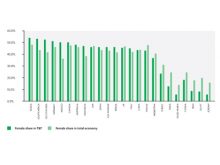 The female share of employment in tourism in India accounts for 12.1 per cent, according to a latest report by World Travel and Tourism Council (WTTC) titled ‘Travel & Tourism: Driving Women’s Success.’ There could be an 11 per cent increase in global GDP if every country achieved the fastest rate of progress in its region on closing the three key gender gaps of workforce participation, the report states. Travel and tourism can provide women with more opportunities for workforce participation, leadership, entrepreneurship and empowerment than many other sectors, particularly in developing countries and as such it can have a tremendous effect on poverty reduction in rural communities.
The female share of employment in tourism in India accounts for 12.1 per cent, according to a latest report by World Travel and Tourism Council (WTTC) titled ‘Travel & Tourism: Driving Women’s Success.’ There could be an 11 per cent increase in global GDP if every country achieved the fastest rate of progress in its region on closing the three key gender gaps of workforce participation, the report states. Travel and tourism can provide women with more opportunities for workforce participation, leadership, entrepreneurship and empowerment than many other sectors, particularly in developing countries and as such it can have a tremendous effect on poverty reduction in rural communities.
At the macro level, a stronger representation of women in travel and tourism relative to other areas of economy is due to the sector’s unique characteristics: often less emphasis on formal education and training, greater emphasis on personal and hospitality skills, flexible working opportunities, and increased options for entrepreneurship that do not require heavy start-up financing. While there are wide variations in gender equality by region, socio-economic class, ethnicity and age, women’s labour force participation rates are gradually approaching those of men in many developed countries, supported by public policies including family support, rights to paid leave, and affordable childcare services for working mothers. Women also have some of the highest rates of participation in developing countries, reflecting economic necessity.
Breaking News
- Tour Blue Holdings Awarded GOOD TRAVEL SEAL, Joins Travelife, and Expands to Northern Sri Lanka with New Jaffna Office
- Anantara Jewel Bagh Jaipur hosts excusive evening in Delhi, plans to expand focus to FIT, MICE & corporate
- Thailand sees 30% increase in flights from India compared to last year
- BaliTrip Wisata to add Sri Lanka and the Philippines to its portfolio from October
- Himachal plans new tourism council to fast-track big projects, attract investment
- India, Japan drive APAC resilience despite global slowdown: GlobalData
- T Syndicate hosts independence-themed travel industry meet in Mumbai
- Malaysia Airlines to Malaysia launch daily flights to Trivandrum by Dec
- Tripura to set up 6 eco-parks, looking to boost tourism in state
- ITC expands North India presence, signs Fortune Hotel, Lucknow
- Kerala to launch first-ever low-interest loan soon to empower women in tourism
 Tourism Breaking News
Tourism Breaking News


